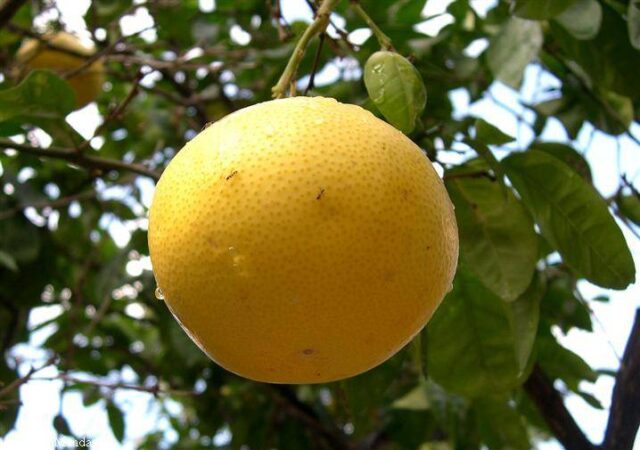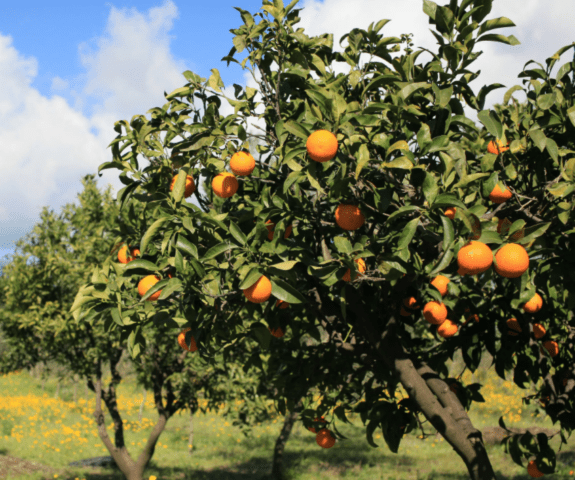Content
Different plants from the Citrus genus are quite easily crossed with each other, both during the experiments of breeders and “spontaneously”. Among the successful interspecific “mixtures” is a hybrid of orange and grapefruit. Like all citrus fruits, it has health benefits and a vibrant flavor. In Russia it is practically unknown, but in America it is actively cultivated on an industrial scale.
What is the name of a grapefruit crossed with an orange?
The official name of the orange-grapefruit hybrid is orangelo. But in its homeland, in South and Central America, it is more often found under the nickname chironja (“chironya”, “chironya” or “chironha”, depending on the local pronunciation). It directly indicates the “pedigree” of the hybrid. In Puerto Rico, sweet oranges are called china; grapefruits are called toronja in Spanish.
Description of a cross between orange and grapefruit with photo
A hybrid of orange and grapefruit - an evergreen, powerful, tall tree. The average length is 10-15 m, the oldest specimens reach 20 m. The shoots are densely leafy, the leaf blades are rich green in color, almost indistinguishable from grapefruit, but slightly smaller.

In gardens and plantations, the height of a hybrid of grapefruit and orange is limited to 3-5 m for ease of care and harvesting
Since the homeland of orangelo is the subtropics, the hybrid of orange and grapefruit blooms late, the fruits ripen in the middle or late autumn. The flowers are large, with five snow-white petals, spreading a pleasant aroma.

In optimal climate conditions, trees can bloom almost all year round
Orange fruits are large and varied in size (weight varies between 250-350 g, diameter - 10-15 cm). The shape can be almost spherical, pear-shaped, or ovoid. From grapefruit, the hybrid “inherited” a rather pale yellow-orange peel, reddish-pink flesh and large size. From the orange - the chemical composition, juiciness and sweetness of the pulp.

The taste of the hybrid completely lacks the typical bitterness of grapefruit.
History of the origin of citrus
Orangelo is a hybrid of orange and grapefruit, “bred” by nature itself. The result of spontaneous crossing was discovered in Puerto Rico, on one of the test plantations in the highlands, in 1956. Carlos G. Moscoso, an employee of the local state university, working in the agricultural extension department, discovered several trees among the citrus plantings with fruits that were different in size, skin color and taste from most.

New types of citrus fruits often appear due to cross-pollination, but not all of them are valuable.
After a series of studies, the “random” hybrid was recognized as promising for cultivation on an industrial scale. The version that its “parents” are orange and grapefruit was confirmed after breeders conducted an experiment on controlled crossing of these citrus fruits. The resulting hybrid had the same characteristics as the previously discovered tree.
After work on “fixing” varietal characteristics and selecting the best representatives of the new species, which lasted until the early 60s of the twentieth century, the “mixture” of grapefruit and orange, called “orangelo,” quickly spread throughout Central, South and North America. This citrus is also cultivated in the Mediterranean, although in a smaller volume.
Useful properties of the hybrid
Like any citrus, a hybrid of orange and grapefruit has a low calorie content (60-65 kcal per 100 g) and a rich chemical composition. It will be a valuable addition to any diet.

Like any citrus, more than 80% of orangelo consists of water, and it also contains a lot of dietary fiber (4.5 g per 100 g)
Of the “common” vitamins, macro- and microelements vital for the body, the hybrid of orange and grapefruit contains:
- Vitamin C. This is the most important “catalyst” necessary to maintain immunity and activate any regenerative processes in the body. It is especially needed by blood vessels, helping to strengthen their walls. Without vitamin C, the body is unable to absorb iron.
- Almost all B vitamins. Each of them plays an important role in metabolism. Without vitamin B1, protein, lipid, and carbohydrate metabolism are disrupted, and the water-salt balance is disrupted. Vitamin B2 is involved in almost all oxidation and reduction reactions, B6 – in the synthesis of amino acids, B9 ensures the “transport” of carbon to cells necessary for the production of hemoglobin.
- Vitamin E. The most powerful natural antioxidant contained in a hybrid of orange and grapefruit. It neutralizes the negative effects of free radicals on the body, slowing down the aging process. With its deficiency, the risk of developing cancer and blood clots increases.
- Potassium. It has a beneficial effect on the cardiovascular system, preventing the development of arrhythmia. Plays an important role in supplying the brain with oxygen, maintaining normal water-salt and acid-base balance.
- Calcium. This trace element, contained in a hybrid of orange and grapefruit, is the basic “building material” for bone, cartilage and connective tissue. It is also involved in the processes of blood clotting, lipid burning, insulin synthesis, and activates metabolism.
- Magnesium. Without it, the normal functioning of muscle fibers and nerve cells and the removal of waste and toxins from the body are impossible. This is a valuable “support” for the endocrine system. With magnesium deficiency, the risk of developing cholelithiasis and urolithiasis increases.

The orange-grapefruit hybrid is superior to many other citrus fruits in terms of vitamin C content.
The rich chemical composition determines the “multifaceted” benefits of the orange-grapefruit hybrid for the body:
- strengthening the immune system;
- help in the fight against extra pounds;
- normalization of the stomach and intestines;
- reducing the level of “bad” cholesterol in the blood, dissolving “plaques”;
- strengthening the walls of blood vessels;
- beneficial effects on the brain and nervous system as a whole;
- “support” of reproductive function in men and women;
- reducing the severity of symptoms typical of toxicosis and menopause;
- anticonvulsant effect.

No new fundamentally beneficial properties have been identified in the orange-grapefruit hybrid compared to its “parents”
Harm and contraindications
Like any citrus, a hybrid of orange and grapefruit can cause allergies. The intensity of the reaction in case of individual intolerance varies from rash, redness, mild burning to severe itching, severe swelling, attacks of nausea, vomiting, dizziness, and breathing problems.
The list of contraindications that prevent the inclusion of an orange-grapefruit hybrid in the diet is not limited to the presence of allergies:
- Age up to three years. It is in children that an allergic reaction to a hybrid of orange and grapefruit and other citrus fruits manifests itself most often and most intensely. In addition, the stomach is not yet able to produce enough enzymes to quickly digest the fiber-rich pulp - cramps or pain in the abdomen are very likely.
- Increased acidity of gastric juice. Orangelo increases it further, causing an attack of heartburn.
- Chronic gastritis, colitis, peptic ulcer.The pulp and juice of a hybrid of orange and grapefruit are more irritating to the affected mucous membrane, which can lead to an exacerbation of the disease.
- Taking certain medications, primarily oral contraceptives, antibiotics, antidepressants, analgesics, medications prescribed for patients with cancer, erectile dysfunction and chronic hypertension.
It is possible that an allergy to citrus fruits detected in a child at 3-4 years old will “spontaneously” go away by the age of 7-8 years, but it happens that it persists in adults.
Conclusion
A hybrid of orange and grapefruit, also known as orangelo, is extremely rare on sale in Russia. The local climate also does not allow it to be grown in open ground. Like all citruses, it is valued for its original, refreshing taste and rich chemical composition, which means significant benefits for the body. However, there are also contraindications that need to be taken into account before including it in the diet, so as not to cause harm to health.








